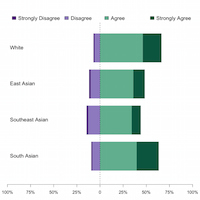How to Recruit More Diverse Students: Challenges and Opportunities
 By Colleen Arendt and Rebecca Dohrman
By Colleen Arendt and Rebecca Dohrman
In an era when the media talks about higher education in unique ways—such as focusing on the need for universities to display high post-graduation job placement rates and higher starting salaries to justify increasing tuition, and the need for college students to be well trained for the available opportunities in our national labor force—computing is perfectly positioned for recruiting prospective students. Indeed, for some groups and universities, growth in the area of computing has been strong and continues to grow (Zweben & Bizot, 2015). One fact sometimes cited by programs looking to encourage prospective students to matriculate in their major is to say that workers in STEM disciplines command higher wages, earning 26% more than their non-STEM peers. Another message focuses on the fact that workers with STEM degrees earn more even when they do not work in a STEM occupation (Langdon, McKittrick, Beede, Khan, & Doms, 2010). Despite the fact that these messages are well received by some individuals, for others, these messages are not sufficient to recruit them into a computing program.
Creative Effective Messaging
For women and underrepresented groups, general messages about high salaries and excellent job placement rates are important, but may not be sufficient to encourage them to matriculate. Certainly, students from some underrepresented groups face a variety of barriers to inclusion, such as family pressure to begin work immediately after high school, family pressure to stay near one’s hometown rather than moving to a university with a strong program in computer science, or a lack of knowledge about possible computing careers. These challenges must be responded to in terms of messaging. Cohoon (2011) argues that while many messages about computing appeal to both women and men, such as economic security and job satisfaction, there are additional messages that can be specifically appealing to women. For instance, Cohoon (2011) found that women responded more strongly than men to messages that positioned computing as a profession that helped others and as a profession where self-expression was possible. For instance, this might mean that instead of talking about hacking as a possible profession on a brochure, roadshow, or admissions presentation about the computing department, instead focus on the way that computing and robotics makes it possible for people who do not have full use of their hands to regain that ability, thanks to the contemporary work on robotics. Second, demonstrating computing as self-expression may be accomplished by including messages in marketing materials and admissions presentations about the range of computer animation for children and adults that intersects with the movie and television industry or the current efforts made in wearable technology that intersects with the fashion industry. These examples illustrate computing as both helping others and allowing self-expression.
In addition to the language used in your messaging, the media representations that are included in your department website, presentations, and on social media also communicate a great deal about what type of students you have in your program and who you seek to recruit to your program, which then may impact the confidence level that prospective students, particularly individuals from underrepresented groups, have toward their ability to complete your major (Cheryan, Plaut, Handron, & Hudson, 2013). Using resources such as the #WOCinTech stock photo set (available here for free) and the Microsoft DigiGirlz profiles of women coders (available here) are wonderful ways to ensure that the video and graphical elements of your department’s presence online, in printed marketing materials, and in formal presentations is sending the message that you want to recruit students, including women, into your program.
The Importance of Influencers
In addition to the messages being sent, programs must consider the range of influencers who affect prospective students’ decision whether or not to choose computing for their major. Traditional agents of socialization, such as family members (especially parents), are still very strong with contemporary prospective students, but in addition to those traditional influencers, many celebrities are crafting resources to help influence young people to consider computing. For instance, model Karlie Kloss released a YouTube video last year that talked about coding as a superpower and encouraged young women to consider a career in computing. The video has more than 100,000 views and, given her influence in the lives of many young women, it serves as a great resource for computing programs to help prospective female students feel engaged in the study of computing. In addition, useful resources for reaching out to underrepresented minority students include TECHNOLOchicas.org, a website and video database geared toward young Latina women to engage them in computing, YouTube videos by both President Obama and actress Jessica Alba, in which they share their own interest in learning computing (Obama video here, Alba video here). These resources highlight the importance of well-known influencers in the lives of young people and provide ready-to-use formats for computing departments to link to on social media or their websites, or perhaps even to include in admissions presentations to prospective students.
An Important Strategy Resource for Recruiting
The National Center for Women in Information Technology Extension Services Program (NCWIT-ES), founded by Lecia Barker and Joanne Cohoon, has produced a series of documents meant to help recruit students, particularly women, into undergraduate computing programs. Tailoring messages to underrepresented groups across all marketing materials, social media, and online platforms is an important first step, and training faculty and any individuals, such as your admissions staff, to tailor their messages about your program and department is also very important.
NCWIT-ES has produced a high-quality workbook (available here) to help walk a department through the many possible interventions and steps you can take to recruit more women into your computer science or engineering program. It is an excellent resource to deepen your understanding about the many possible audiences, ways to target them, and how to evaluate your efforts. It also helps you to think through your existing assets and evaluation practices to ensure your overall recruiting strategy is on target and has the best opportunity for success.
Another important resource from NCWIT is the Aspirations in Computing Program. It includes an awards ceremony and talent development pipeline that takes place in local communities across the country where female high school students are honored for their aspirations and achievements in computing. Corporations in the local communities act as sponsors and universities often provide scholarships to Aspirations winners if they attend the university and study computing science. Women who win this award or a runner-up for it are able to apply for the NCWIT AspireIT program, which provides these students with funds to create “near-peer” programs for younger students to engage and interest them in computing. Many Aspirations winners participate in the creation of these programs for younger students, and it is a wonderful way to keep them engaged in the computing community.
NCWIT also offers a Collegiate Award for female college-aged computing students that provides winners with a cash prize, a trip to the NCWIT Summit, and continued encouragement to persist in computing.
In short, recruiting women and underrepresented groups into your computing major is an essential component of any recruiting strategy for computing departments, and many strategies can help you in this effort. Numerous resources are available to aid you in this effort and to ensure that your efforts to recruit new students are inclusive of the many different types of students from many backgrounds and interests that exist. This work may be tedious at times, but we believe it is essential to the future of computing education in the United States.
References:
Cheryan, S., Plaut, V.C., Handron, C., & Hudson, L. (2013). The stereotypical computer scientist: Gendered media representations as a barrier to inclusion for women. Sex Roles: A Journal of Research, 69, 58-71.
Cohoon, J.M. (2011). Recruiting messages for more and different students. (Presentation.) Retrieved here.
Langdon, D., McKittrick, G., Beede, D., Khan, B., & Doms, M. (2010). National occupational employment and wage estimates. U.S.
Department of Commerce (Report). Retrieved here.
NCWIT (2015). Recruit strategically: A “high yield in the short term” workbook for attracting women to undergraduate computing and engineering. Workbook. Retrieved here.
Zweben, S. & Bizot, B. (2015, May). 2015 Taulbee survey – Continued booming undergraduate CS enrollment; Doctoral degree production dips slightly. CRA Newsletter. Retrieved here.
About the Authors: Colleen Arendt (Ph.D., Purdue University) is an assistant professor of communication at Fairfield University. Her research focuses on gendered careers, such as the military and nursing, and how to recruit more women into STEM. Rebecca Dohrman (Ph.D., Purdue University) is an assistant professor of communication at Maryville University and an Extension Services Consultant with the National Center for Women in Information Technology. Her research focuses on the socialization of children, particularly young girls, into high-tech careers and the ways that we can use narrative storytelling to improve math engagement for young children.








